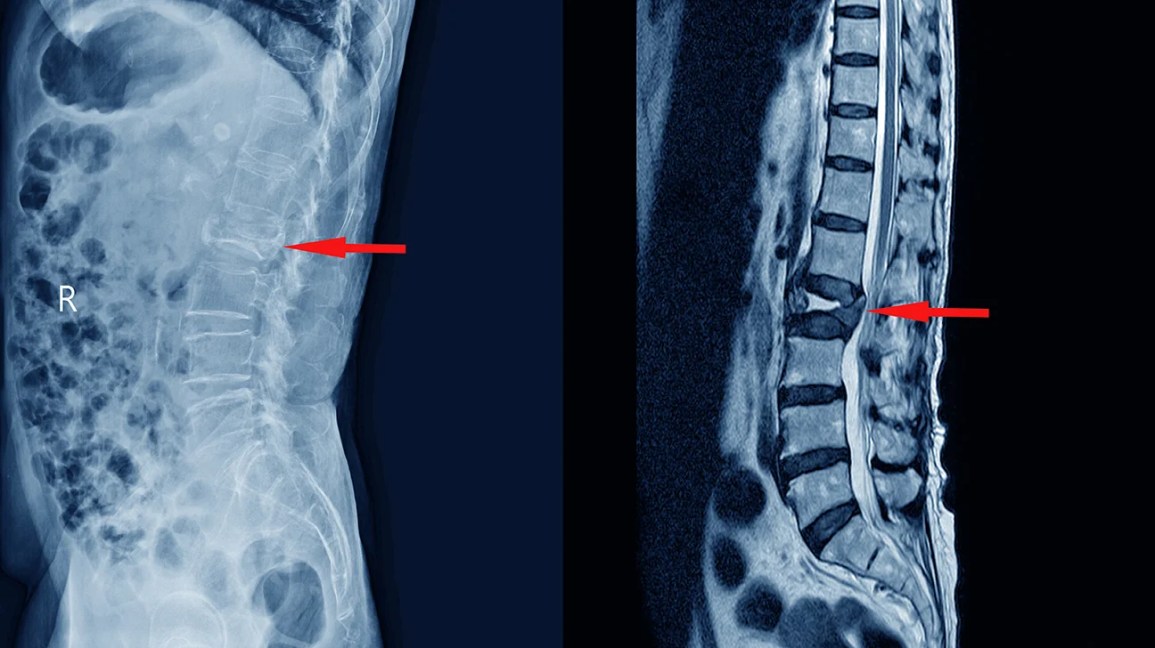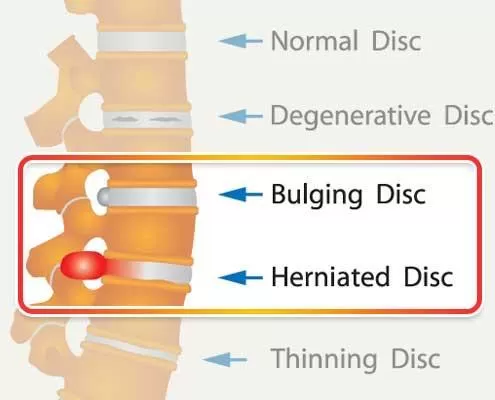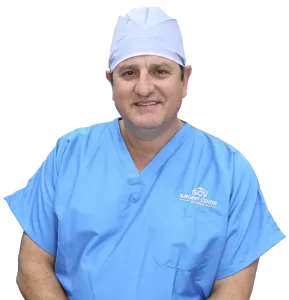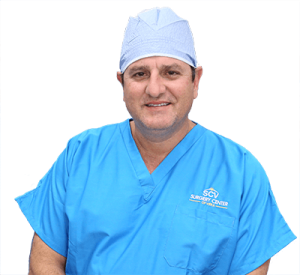Experiencing persistent lower back pain? Bulging disc treatment can be the key to regaining your mobility and comfort. A bulging disc occurs when the disc between the vertebrae bones of the spine ruptures or shifts outside of the area it should be in.
While initial symptoms may be mild, left untreated, a bulging disc can lead to significant pain, numbness, and weakness.
Fortunately, various treatment options exist to address bulging discs. This blog post will guide you through the available treatment options, including surgical and nonsurgical methods.
A bulging disc happens when the disc—a soft tissue sac—between the vertebrae bones of the spine ruptures or moves out of its designated area. Also referred to as a ruptured or slipped disc, this condition can manifest in the neck region but is predominantly found in the lower back, known as the lumbar area.
Initially, a bulging disc might not cause noticeable symptoms due to the absence of nerve contact. However, with a lumbar bulging disc, chronic pain, numbness, and tingling can develop in the buttocks and leg, a condition known as sciatica. A bulged or slipped disc cannot revert to its original position naturally, and over time, as one ages, the disc tissue becomes drier and less flexible, intensifying the painful symptoms.

Bulging discs are frequently mistaken for herniated discs, yet there is a difference. A bulging disc occurs when the internal soft tissue exits the disc, leading the disc to deflate like a tire and bulge outward. However, a herniated disc occurs due to a crack in the disc’s outer cartilage layer, allowing the softer inner cartilage to protrude through the disc. Both conditions can cause discomfort and warrant evaluation and treatment by a healthcare provider.

Here are the primary causes of bulging discs:

The symptoms of a bulging disc can vary widely depending on its location in the spine and whether the disc is pressing on nerve roots. While some individuals may experience no symptoms at all, others can face significant discomfort and mobility issues. Here are key symptoms that may indicate the presence of a bulging disc:
This is the most common symptom, which can range from mild to severe. The pain may be localized to the area of the bulging disc or, if the disc is pressing on a nerve, it can radiate along the nerve pathway. For example, a bulging disc in the lower back may cause pain that radiates down the leg, known as sciatica.
If the bulging disc is in the lumbar (lower back) region and pressing on nerves that affect leg function, individuals may experience difficulty walking or changes in their gait.
As a bulging disc is often a sign of disc degeneration, individuals might also experience symptoms associated with this broader condition, such as stiffness, reduced flexibility in the spine, and pain that worsens with movements like bending or twisting.
Bulging discs can often be treated with exercises, physical therapy, and interventional pain management techniques. Sometimes these treatments do not offer enough relief, and patients may require surgery to provide relief from bulging disc pain.
The following are surgical procedures that can be used to treat bulging discs:
Deuk Laser Disc Repair is a type of endoscopic spine surgery conducted in a state-of-the-art outpatient surgery center under sedation, allowing the patient to remain comfortable. This technique does not compromise or weaken the health and integrity of the spine.
With over 15 years of experience performing this procedure and more than 2000 patients treated, there has been a remarkable 99.6% success rate without any complications.
How Deuk Laser Disk Repair Functions
Deuk Laser Disc Repair involves making a very small incision, barely a quarter-inch long. A cylindrical instrument known as a dilator is inserted into this tiny opening to gently separate the muscles, creating a pathway for performing the surgery endoscopically.
The dilator’s end is inserted into the affected disc via the tear in the annulus where the herniation begins. A retractor tube is placed over the dilator and positioned carefully within the painful disc. The entirety of the Deuk Laser Disc Repair surgery takes place within this narrow tube.
An endoscopic camera is placed into the tubular retractor, enabling the surgeon to accurately direct the laser inside each symptomatic disc. This method ensures that bones and surrounding tissues remain unharmed, unlike traditional spinal fusion, microdiscectomy, and artificial disc procedures.
The Holmium YAG laser, utilized in the Deuk Laser Disc Repair, is precisely controlled with millimeter accuracy under endoscopic view to excise only the painful, inflamed tissue from the disc. The laser specifically targets and removes the damaged disc material responsible for the pain.
After the laser has eliminated the inflamed, painful sections of the annular tear and the herniated nucleus pulposus, the endoscope and tubular retractor are withdrawn, leaving a small incision in the skin, which is sealed with a single stitch and a band-aid.
The complete Deuk Laser Disc Repair surgery lasts about one hour, with the patient spending approximately 45 to 60 minutes in recovery before being discharged to return home. No hospitalization is required, thus avoiding the risks associated with hospital-based surgeries.
Moreover, Deuk Laser Disc Repair maintains normal movement and flexibility of the disc and joint. This endoscopic procedure does not involve fusion, metal implants, or biological materials added to the spine, making it a completely natural process that allows the body to heal the herniated or bulging disc on its own.
Post-surgery, patients of Deuk Laser Disc Repair can return home and quickly resume daily activities without pain, benefitting from a rapid recovery. Notably, there is no need for opioids or strong narcotic painkillers after surgery.
In contrast to open spine surgeries like microdiscectomy, laminectomy, artificial disc replacement, and fusion, which cause considerable internal trauma and severe postoperative pain requiring painkiller use for extended periods, Deuk Laser Disc Repair avoids these issues.
Spinal fusion surgery can be performed using general or local anesthesia, depending on the situation and surgical requirements.
Spinal fusion can be broken down into three elements which involve:
There are two types of discectomy surgery available to patients: an open discectomy or a microdiscectomy.
The key difference is that an open discectomy involves:
This method increases the potential risk of nerve damage to the adjacent nerves of the vertebrae. Furthermore, the spinal column may become unstable from the removal of bones, ligaments, and facet joints.
In these situations, a spinal fusion is performed after the discectomy to reestablish stability in the spinal column, slightly lengthening the patient’s recovery time.
For individuals dealing with a bulging disc, non-surgical treatment options can provide significant relief and are often the first line of approach in managing symptoms. These treatments aim to reduce pain, improve function, and promote healing, potentially avoiding the need for surgery.
Over-the-counter pain relievers and anti-inflammatory drugs can help alleviate pain and reduce inflammation. In more severe cases, stronger medications, such as muscle relaxants or prescription-strength anti-inflammatories, may be recommended.
A tailored physical therapy program can strengthen the muscles around the spine, increase flexibility, and reduce the pressure on the affected disc. Physical therapists may also employ techniques such as traction, massage, and ultrasound to help relieve symptoms.
Epidural injection can provide temporary relief by reducing inflammation and pain in the affected area. This option is often considered when other treatments have not provided adequate relief.
This FAQ offers insights into managing a bulging disc, including recognizing worsening symptoms, deciding on surgery, preparing for it, post-surgery expectations, and understanding success rates.
The following are signs bulging disc is getting worse:
Surgery might be considered when:
Here’s what you need to expect after a bulging disc surgery:
Success rates for bulging disc surgery vary depending on the specific procedure, patient health, and severity of the disc bulge. For surgical procedures such as Deuk Laser Disc Repair, the success rate is 99.6% with 0 complications.
Bulging discs can often be treated with exercises, physical therapy, and interventional pain management techniques. Sometimes these treatments do not offer enough relief, and patients may require surgery to provide relief from bulging disc pain. Thankfully, Deuk Spine Institute provides a minimally invasive bulging disc surgery that has an excellent success rate and a fast recovery.
Deuk Laser Disc Repair uses a small incision and does not cut the bone, which can weaken the spine. Our advanced bulging disc surgery avoids the unpleasant side effects that most traditional spine surgeries incur, and has a 99.6% success rate, with 0 complications, and a very short recovery time.
Start your journey on a pain-free life

